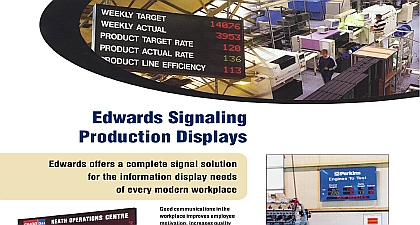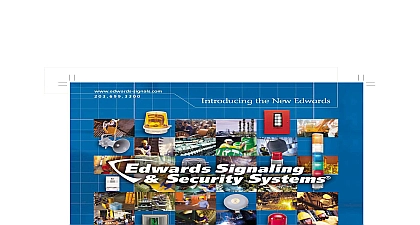Edwards Signaling Selection Guide

File Preview
Click below to download for free
Click below to download for free
File Data
| Name | edwards-signaling-selection-guide-5631840297.pdf |
|---|---|
| Type | |
| Size | 1.16 MB |
| Downloads |
Text Preview
Quick Selection Guide EDWARDS AUDIBLE VISUAL SIGNALS SIGNALING BASICS the soft melodic sound of a chime to the ear piercing emergency blast of an outdoor warning signal Edwards audible produce sounds that demand immediate attention SIGNALS AND THEIR APPLICATIONS and Single Stroke Bells 8 and 10 bells are used for alarms over large areas as distribution centers 4 bells are used for smaller Single stroke bells are most useful for paging Horns to signal attention and equipment condition in process lines and other areas requiring human interface often used for local annunciation of noncritical events can also be used when a distinctive paging signal is for relatively quiet locations to page or locally and Outdoor Warning Signals use in general services and emergency warning over geographic areas Tone Signals in stand alone and signaling systems that require tone selectability and flexibility Signals where the delivery of specific instructions are required PRESSURE LEVELS pressure fluctuations diminish or out with increas distance from the sound source A distance must gener be specified along with the dB rating to fully describe a sound pressure level changes 6 dB for each halving or of distance For a change in distance of ten times sound pressure level changes 20 dB DB LEVELS WHEN SELECTING SIGNALS specifying a signaling device the above characteristics be considered along with as many factors concerning application as can be gathered Selecting the proper de for each signaling application need not be difficult if the points are observed Signal Function the types of functions to which signals can be ap are general alarm or emergency start and dismissal or coding localized danger and indication first step in selecting a signal is to carefully define this Is the signal to be a warning a call or an instruc Will it be used to protect life or property How much will be available to take action the more critical the application the more startling signal generated must be A horn is generally the most signal Its rasping tone commands immediate atten A single stroke bell can be used for paging applications danger is not at hand A small buzzer may serve to a machine operator that a particular operation is com Uniform Sound Distribution better signal distribution can be achieved by carefully a number of smaller signals throughout a given than by centrally locating a single large unit Ambient Sound Conditions frequency of the signaling device selected should be as from the background noise as possible The signal override this noise by a minimum of six decibels Usu the noisier the area the louder the signal required and greater the number required Size of Area to be Covered larger the area the louder the signal required or the the number of units required Better coverage is fre obtained by the use of several signals of lower dB than by the use of one very loud signal providing the can be positioned to advantage Mounting Considerations surface that the signal is mounted on can markedly affect signal performance A horn for example should be rig mounted to a sturdy surface so that all of its energy is di into the sound output and not absorbed by the wall A however can sound much louder if mounted on a surface because it will act as a board for the NUMBER VOLTAGE SUFFIXES audible signals are available in a wide variety of Each signal has a catalog number suffix which the voltage of that specific signal The following is a of the cat number suffixes and the voltages they Voltage AC DC DC DC DC DC DC Voltage AC 50 60 Hz DC DC AC 50 60 Hz AV 50 60 Hz DC SIGNALING BASICS the amber light of a rotating beacon at an airport to the double flash of a red strobe in a Division 2 area Edwards provides widest array of visual signaling solutions in the industry The following is a brief overview of some of the types of visual and applications TYPES AND THEIR APPLICATIONS Beacons to signal over a large area such as in airports centers and large process areas Beacons to signal attention and equipment condition in process lines airport baggage areas and other areas human interface Flashing Beacons to signal attention and equipment condition over wide Sometimes used in lieu of Rotating Beacons Beacons to identify a continuous source or process Lights for equipment status and malfunction indication over and high noise areas Supervised and UL 1971 Strobe Lights polarized strobes are used in electronically alarm circuits When the strobe has a UL 1971 it may also be used in compatible fire alarm systems a signaling device for the hearing impaired COLORS AND THEIR APPLICATIONS Edwards strobes steady and flashing beacons come in lens colors amber blue clear green magenta and red LED signals come in amber blue green red and some cases white The following are examples of how lens colors are used in industrial and commercial environments caution for safety and security or White Green to indicate normal run operation for radiation alarms emergency or warning SOURCES AND THEIR signals use a variety of light sources halogen incandescent LED and strobe The following is a overview of these type of light sources and their use in areas where vibration resistance and long life are of concern Light output with older technology LEDs is poor newer technology LEDs have vastly light output but are still expensive in areas where high light output and long life are Halogen light sources work well in high light areas However halogen bulbs tend to perform in high vibration environments light sources are typically the most They are often used in applications where cost a driving factor Incandescent bulbs tend to have a short life span Their light output while usually is less than that of a halogen or strobe are known for their exceptional bright burst of light A strobe light passes a brief intense pulse of electric through a gas which then emits a brilliant burst of The gas is usually one of two inert gases xenon or Strobe lights are very vibration resistant and will for thousands of hours before requiring NUMBER VOLTAGE SUFFIXES visual signals are available in a wide variety of Each signal has a catalog number suffix which the voltage of that specific signal The following is a of the cat number suffixes and the voltages they Voltage AC DC DC DC DC DC DC Voltage AC 50 60 Hz DC DC AC 50 60 Hz AV 50 60 Hz DC LOCATION DEFINITIONS principles of sound and light apply to hazardous location as they do to regular audible and visual signals How an added factor must be taken into consideration the environment where the signal will be used Information in this section is provided to assist in signal only Classification of areas in which equipment is to located is the responsibility of the authority having jurisdic ENVIRONMENT Location Environments are those indoor or out areas where a potential explosion and or fire may exist to the presence of flammable gases liquids or vapors I combustible dusts Class II or ignitable fibers or Class III Whatever the reason for the hazardous loca to exist it is essential that every precaution be used to pre ignition of these hazardous atmospheres A SOURCE OF IGNITION explosion in a hazardous location atmosphere may result a simple burst of ignition energy from common electrical The routine usage of circuit breakers motor starters switches plugs and receptacles releases energy the form of arcs and sparks as their contacts close and source of an ignition could come from the breakdown in electrical system or a power surge Sparks arcs and heat come from loose wire connections in a splice box or the of insulation from aging or breaking Static electricity is a potentia


